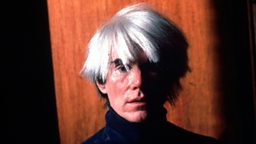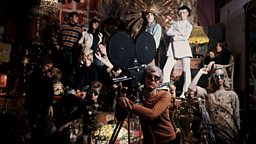Andy Warhol: Evil Exploiter of Everyone or Visionary Artistic Genius?
Was he a prophetic, inspirational powerhouse who changed the history of art forever? Or a strange, silent fraud who was more focused on commerce than creativity and enjoyed the pain of others?
Every week on Evil Genius with Russell Kane, a notable figure from yesteryear has their personal lives dissected and analysed by a trio of sharp-witted comedians who then decide if they should be put on a pedestal or flushed down the WC of history.
Andy Warhol certainly had an impact on art and popular culture. Sara Barron, Helen Bauer and Darren Harriott joined Russell to delve into the life and actions of this be-wigged sixties icon and decide if he was a good’un or a wrong’un.
Here's what they found…

For: He made art accessible
After spending a huge amount of time in bed as a child with various ailments, Andy Warhol spent much of his early life reading comics and magazines. This popular culture crept into his later artworks, turning him into the “poster boy for pop art”.

He wanted his art to be available to all, churning out screen prints, Brillo pad boxes, silver balloons and images of everyday objects such as dollar bills and coke bottles. As Helen points out, with his art: “You feel included.” Warhol’s work is instantly recognisable, just as he is. He turned himself into an artwork with his iconic glasses and silver wig. And it’s effective – Sara says Warhol’s art “makes me feel smart, not stupid”.
Against: He turned art into a business
Warhol created so much product that it seemed as if he was only interested in making money and doing good business, rather than creating beautiful, meaningful works of art.
He would often use screen-printing companies that he didn’t even visit to make his artworks and simply signed the results. As Russell explains: “People are paying a lot of dollar for something and he’s saying ‘yeah, just go print that over there’.” Other artists hated his approach, considering him a sell-out who put commerce before creativity.
For: He was insanely successful
Arguably, Warhol is more successful now than when he was alive. Even though he amassed a huge fortune before his death in 1987, since that time his work has escalated in value. One of his Marilyn paintings recently sold for $195 million, the most anyone has ever paid for a 20th-century work of art.
He made screen-prints and films of the most famous people on the planet, work that could be quickly created and replicated. While critics could be sceptical of his work, museums and collectors clamoured for it. His images are everywhere, as Darren says: “I’ve seen so many copies in pound shops.”

Against: He was viciously exploitative
As well as outsourcing his artworks for other people to produce, Warhol could also be off-hand, even cruel, with those around him. He set up his first "Factory" in 1964, a huge studio where he worked but which was also a haven for the dispossessed. Artists, poets, actors, drag queens, addicts and eccentrics spent their days and nights at Warhol’s Factory.

He understood we are all narcissists.Sara Barron
Debauchery often occurred, but Andy would only observe, often filming the mayhem. Once he was tired of people and their exploits, they would be "excommunicated", removed from Andy’s circle, then ignored. When one of the Factory regulars threw themselves out of a window, Warhol is reported to have said, “I was sorry I wasn’t there to film it,” which prompts Sara to wonder if “there’s a disconnect there, he’s not really feeling his feelings”. There were many deaths surrounding Warhol (he was nearly killed himself when shot in 1968 by a disgruntled Factory-goer). But he never seemed too concerned, just a mildly amused observer. As Russell identifies: “He definitely could and should have done more.”
For: He was incredibly inventive
If Warhol had simply stuck to his pop art paintings, his place in art history would have been assured. But he had a fearsome energy and boundless ambition, moving into many other creative areas. He sculpted, started making films, took photographs, produced Broadway shows, had his own TV programme and managed the seminal rock group The Velvet Underground. Despite this diversity of work, it was all identified with him and his iconic look. As Russell claims on the podcast: “He was branding himself from the beginning.” He was restless and wanted to continually pursue interesting creative outlets.
Against: He created disposable celebrity culture
Warhol’s most famous quote was: "In the future, everyone will be world-famous for 15 minutes.” In our multi-media saturated times, this can sometimes feel like more than a threat than a prophecy. “Things are getting faster and faster and they start from him,” says Russell.
Warhol idolised celebrity culture and also filmed and recorded much of what was going on around him, from the exciting to the mundane, just as a vlogger would today. His whole world, good or bad, became his creative outlet, or as Russell puts it: “He hybridised fame with art.” His obsession with disposable culture, the commercialised world and our own fascination with ourselves feels very modern. As Sara puts it: “He understood we are all narcissists.”
So what did the panel decide? Was Warhol a masterful, creative powerhouse or a creepy, mean-spirited voyeur? You’ll have to listen to Evil Genius to find out.
More from 成人论坛 Radio 4
-
![]()
Evil Genius: Picasso
Tom Allen, Suzi Ruffell and Harriet Braine paint a wonky picture of the great artist.
-
![]()
Evil Genius: Salvador Dali
Jen Brister, Esther Manito and Larry Dean wax their moustaches ready to talk Salvador Dali.
-
![]()
You're Dead To Me
The comedy podcast that takes history seriously. With Greg Jenner and guests.
-
![]()
The Curious Cases of Rutherford and Fry
Science sleuths Dr Adam Rutherford and Dr Hannah Fry investigate everyday mysteries sent by listeners.




